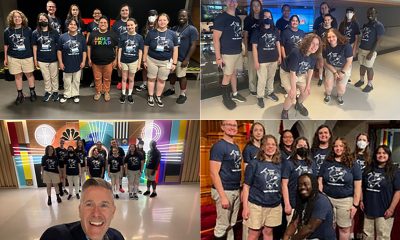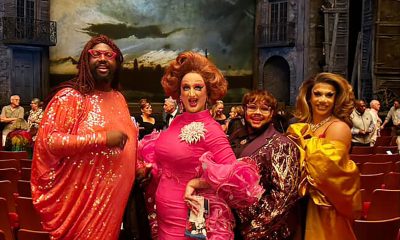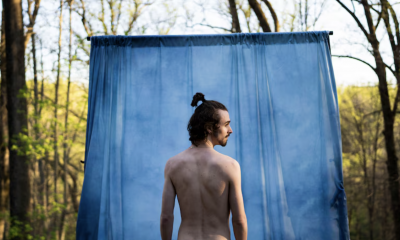a&e features
Queer Alvin Ailey dancers ready triumphant Kennedy Center return
Three LGBT performers on why dance is their artistic medium
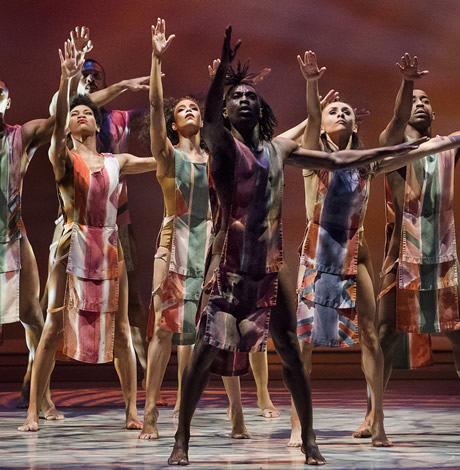
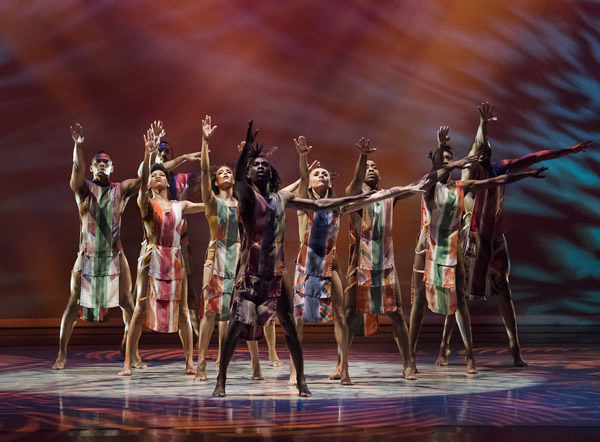
The world-renowned Alvin Ailey American Dance Theater returns to the Kennedy Center Feb. 4-9 for its annual winter engagement. Led by Artistic Director Robert Battle, this year’s program will include regional premieres of three works, two entirely new productions and two company premieres.
Tickets start at $49. Full details on time, dates and more is online at kennedy-center.org.
We asked three of the company’s LGBT dancers to share their training, favorites, goals and more.
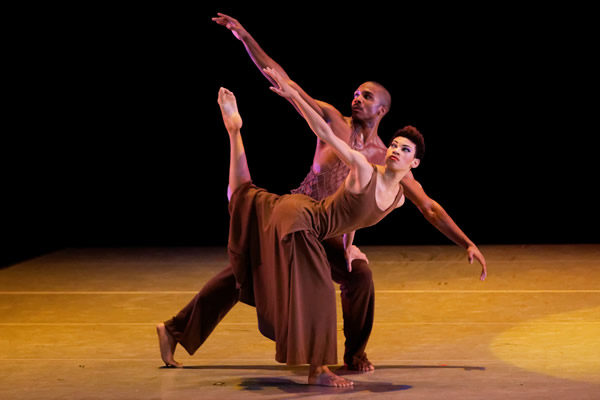
NAME: Ghrai DeVore-Stokes
HOMETOWN: Washington, D.C.
AGE: 30
RELATIONSHIP STATUS: Married
IDENTIFY AS: I don’t subscribe to labels but if forced, I would say either queer or pansexual.
CURRENT CITY OF RESIDENCE: Brooklyn
HOW LONG WITH ALVIN AILEY: 10 years
WHAT DREW YOU TO THE COMPANY: Mr Ailey died on the day I was born so I always felt a connection to him. Also I was inspired by the work that the company has done to celebrate and illuminate the African diaspora and the lives and legacies of people of color in America.
BRIEFLY DESCRIBE YOUR DANCE BACKGROUND: I have studied and trained extensively in ballet (Vaganova) and modern (Horton and Graham). I have also studied jazz and some tap.
HOW LONG DANCING PROFESSIONALLY? 14 years
FAVORITE CURRENT PIECE TO PERFORM: A mix between Jamar Roberts’ “Ode” and Aszure Barton’s “Busk.”
HOW MANY TIMES HAVE YOU DANCED AT THE KENNEDY CENTER PREVIOUSLY? This year will be my 10th. My first was 10 years ago in my first year with the company.
THOUGHTS ON THE VENUE/AUDIENCE: The Kennedy Center stage is one of the most beautiful stages and theaters I have performed in. I might be a bit biased because D.C. is my hometown, but in all honesty it’s beautiful to come to such a majestic stage as our first stop on our domestic tour usually. The audience also loves us. We always feel the energy from the audiences at Kennedy Center.
BRIEFLY DESCRIBE YOUR PERSONAL PHILOSOPHY OF ARTISTIC EXPRESSION/DANCE: It’s really important to me that I tell a story every time I walk on the stage. I want to invoke a feeling in the audience. I want people to remember their humanity when I’m on the stage. I want people to be able to relate to me as well. I want the audience to have left the theater feeling something.
BRIEFLY DESCRIBE YOUR PERSONAL FITNESS PROGRAM: I got into the company when I was quite young and as the years have passed, it’s become necessary for me to start slower and build up to more strenuous activity. I like to start with some sort of floor work. Maybe a bit of rolling around, feeling my muscles and bones on the floor waking up the joints. Then perhaps a bit of stretching to release the tendons and ligaments. I like an all-inclusive class. That usually means something that incorporates all of the things I will be required to do during the rehearsal day. It’s very important that my back, my neck, my hips and my feet are thoroughly warmed up before I start trying to throw my body around. On the off time I like to do a bit of gym work. Resistance band, elliptical. I also just learned to swim and that’s good for stamina and breath monitoring.
OF ALL THE ARTISTIC MEDIUMS AVAILABLE, WHY DID YOU CHOOSE DANCE? I chose dance because it encompasses so much. You must have a working understanding of musicality. You must be a bit of an actor. Sometimes you must use your voice. All while finding the best angles and being cognizant of the people around you. You’re constantly using your brain and all of your body. It also important to know the aspects of the theater so that you help the crew run the show smoothly. Being a performing artist means you are always learning.
WHO ARE YOUR FAVORITE DANCERS OF ALL TIME? I don’t really have a favorite dancer of all time. My astrological chart doesn’t really allow me to choose one person out of the many who move me. I like dancers who are virtuosic and push boundaries. I like to feel as if at any moment the dancer will fly off the stage and into the cosmos. I love to see someone dancing both with technical prowess and complete abandon.
WHAT LGBT THEMES ARE IN YOUR REPERTOIRE? The fact that the company is made up of dancers who are spanning the spectrum of sexuality means that whenever we walk on stage, we are living and showcasing the truth of our very existence. Take “Ode” for example. There is a cast of men and a cast of women and no matter how we identify, we must love and acknowledge the humanity of our fellow dancers. Our pieces don’t often center around LGBTQ themes but we bring it to the forefront simply because of who we are as people.
WHAT’S THE MOST ARDUOUS/TEDIUS PART OF THE DISCIPLINE/LIFESTYLE? Making sure our bodies are at 100 percent no matter what. More often than not these days it’s difficult for me to get out of bed. It might be hard because I need more sleep or it might be hard because my body is in pain but I have to figure out to get my body working efficiently in order to perform at the caliber that’s required. It’s also hard balancing the personal and the professional. My wife is a teaching and performing artist currently based in Dakar and trying to match our schedules is always tedious. Sometimes you just want to break down but in those moments I think we take comfort and strength from each other as a company so that we can support each other.
WHAT WOULD YOU LIKE TO BE DOING IN 15 YEARS? I’d like to be fluent in at least five languages with three or four more tattoos. I would like to be living in either Japan or Europe and own either land or property somewhere. I’d like to be a model and or working on the silver screen. I’d also like to be a rehearsal director or be setting works for a company. I have a lot of different interests that span all walks of life. I want to be continuing to explore life in 15 years.
NAME: Chalvar Montiero
HOMETOWN: Montclair, N.J.
AGE: 31
RELATIONSHIP STATUS: Single
IDENTIFY AS: Gay
CURRENT CITY OF RESIDENCE: New York, N.Y.
HOW LONG WITH ALVIN AILEY: five years
WHAT DREW YOU TO THE COMPANY?: I was drawn to this company because they looked like me. I had never seen something like that before. On top of that, the control, personality and finesse of each artist are unmatched.
BRIEFLY DESCRIBE YOUR DANCE BACKGROUND: I started my formal training at Sharron Miller’s Academy for the Performing Arts. I attended a few summer intensives at The Ailey School before going to Purchase College at SUNY (state university of New York) and getting my degree in dance. From there I freelanced and worked with great talents, spending most of my time with Kyle Abraham’s Abraham.In.Motion. I joined Ailey II the summer of 2014, and joined the Alvin Ailey American Dance Theater in the spring of 2015.
HOW LONG DANCING PROFESSIONALLY? 11 years.
FAVORITE CURRENT PIECE TO PERFORM: Judith Jamison’s “Divining”
HOW MANY TIMES HAVE YOU DANCED AT THE KENNEDY CENTER PREVIOUSLY: four
THOUGHTS ON THE VENUE/AUDIENCE: This theater is one of my favorite venues of the entire domestic tour. The audience is so generous and tickets are always sold out. D.C. is one of my favorite cities to visit.
BRIEFLY DESCRIBE YOUR PERSONAL PHILOSOPHY OF ARTISTIC EXPRESSION/DANCE: Dance is a natural way to communicate for all humans. I think we are naturally drawn to the arts because it’s the healthiest and most fulfilling way to convey any message. The more we invest in our modes of communication through the arts, the more we heal ourselves as a community/nation.
BRIEFLY DESCRIBE YOUR PERSONAL FITNESS PROGRAM: Outside of dance, the amount of time I spend cross training depends on the demand of the repertoire. I don’t do much cardio because I do that all day in rehearsal. Instead I focus on strength training in my shoulders, back and glutes, making sure those muscle groups are supported.
OF ALL THE ARTISTIC MEDIUMS AVAILABLE, WHY DID YOU CHOOSE DANCE? I didn’t choose dance. I’ve tried it all but nothing felt natural to me besides this form of expression.
WHO ARE YOUR FAVORITE DANCERS OF ALL TIME: Matthew Rushing. Clifton Brown. Bahiyah Hiba, Linda Celeste Sims. Sylvie Guillem. Darcey Bussell. Desmond Richardson. (I can go on and on.)
WHAT LGBT THEMES ARE IN YOUR REPERTOIRE? I don’t see any specific themes of LGBTQ identity in the repertoire. Instead, it’s the responsibility of the artist to bring their truth to whatever they’re given and make sure their authenticity shines through, regardless of the subject matter
WHAT’S THE MOST ARDUOUS/TEDIUS PART OF THE DISCIPLINE/LIFESTYLE? The most tedious, but beneficial, thing is rehearsing. Making sure everyone is on the same page, with the same information is the part that takes the most time, but there’s nothing more rewarding than sharing a stage with your peers when everyone is comfortable and confident in what they know and who they are.
WHAT WOULD YOU LIKE TO BE DOING IN 15 YEARS? In 15 years I see myself being in the other side of the room, cultivating and grooming dancers by way of being a rehearsal director/choreographer. It’s a dream of mine to give back to the next generation of performers, making sure that integrity, excellence and consistency are a few of the core values that are focused on.
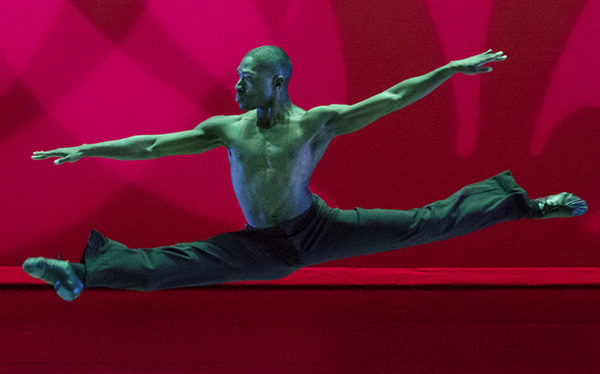
NAME: Michael Jackson, Jr.
HOMETOWN: New Orleans, La.
AGE: 32
RELATIONSHIP STATUS: Single
IDENTIFY AS: Gay
CURRENT CITY OF RESIDENCE: Bronx, New York
HOW LONG WITH ALVIN AILEY: This is my eighth season.
WHAT DREW YOU TO THE COMPANY: I had never seen black people, especially men, move and shown so beautifully elegant and commanding.
BRIEFLY DESCRIBE YOUR DANCE BACKGROUND: Started dancing at the prestigious Duke Ellington School Of the Arts. I first danced professionally with Dance Theatre of Harlem Ensemble company in 2005. Then going on to dance for Dallas Black Dance Theatre and Philadanco before joining Ailey in 2012.
HOW LONG DANCING PROFESSIONALLY? 14 years
FAVORITE CURRENT PIECE TO PERFORM: Jamar Roberts’ “Ode”
HOW MANY TIMES HAVE YOU DANCED AT THE KENNEDY CENTER PREVIOUSLY: My first performance at the Kennedy Center was at the age of 17 back in high school where I attended a Dance Theatre of Harlem Residency led by the spectacular Lorraine Graves. I returned years later with Ailey in 2012 and have been back every year.
THOUGHTS ON THE VENUE/AUDIENCE: The Kennedy Center is beautiful all around. The theater is dripping in elegance and the audience is always lively and engaged. So many historical moments for African-American artists here so that makes it just all the more special.
BRIEFLY DESCRIBE YOUR PERSONAL PHILOSOPHY OF ARTISTIC EXPRESSION/DANCE: I feel that dance is my language and medicine. I am a nervous person and performing most times challenges that. So when the lights and people are stripped away I know that dance on my body heals me.
BRIEFLY DESCRIBE YOUR PERSONAL FITNESS PROGRAM: Our work schedule is so intense so mostly the dancing is enough. But I truly enjoy the gym. I use it for muscle building and rehabilitation. I like getting to choose the intensity of my workout. Mostly based on the intensity of my dance schedule of the season.
OF ALL THE ARTISTIC MEDIUMS AVAILABLE, WHY DID YOU CHOOSE DANCE? It just felt very natural to me from day one. I say it choose me. I didn’t start dancing at a really young age like most. I was thrust into the dance world in high school and never looked back. I know it’s cliché but it was so just much fun!
WHO ARE YOUR FAVORITE DANCERS OF ALL TIME: Alvin Ailey and Arthur Mitchell
WHAT LGBT THEMES ARE IN YOUR REPERTOIRE? Jamar Roberts new work “Ode” is about the victims of gun violence. And a group that knows that subject extremely well is the LBGTQ community. It’s a work with an all-male cast as well as an all-female cast. Though it’s not necessarily token “gay,” I do find dancing with the other men in this work brings a sorrowful yet prideful feeling about my experience as a gay black man.
WHAT’S THE MOST ARDUOUS/TEDIUS PART OF THE DISCIPLINE/LIFESTYLE? The most difficult part for me is the fight for balance when it comes to work and play. Dance is my life and it not only requires a physical demand but emotional as well. I find myself still working on dropping all the emotions of work and focus of personal ones. And vise versa.
WHAT WOULD YOU LIKE TO BE DOING IN 15 YEARS? That’s the question of 2020! I have been dancing for so long and only now am I starting to think about a true next step for me. It’s extremely scary but exciting. But it’s nice to know I can maintain my craft, do what I love, see the world and get compensated for it while I figure it out.
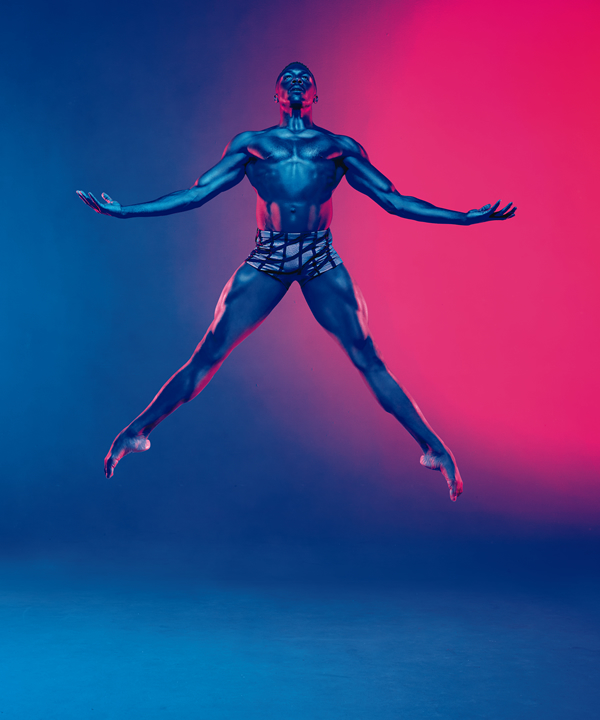
a&e features
Doug Spearman takes his chance
‘Noah’s Arc: The Movie’ debuted on Paramount+ last month
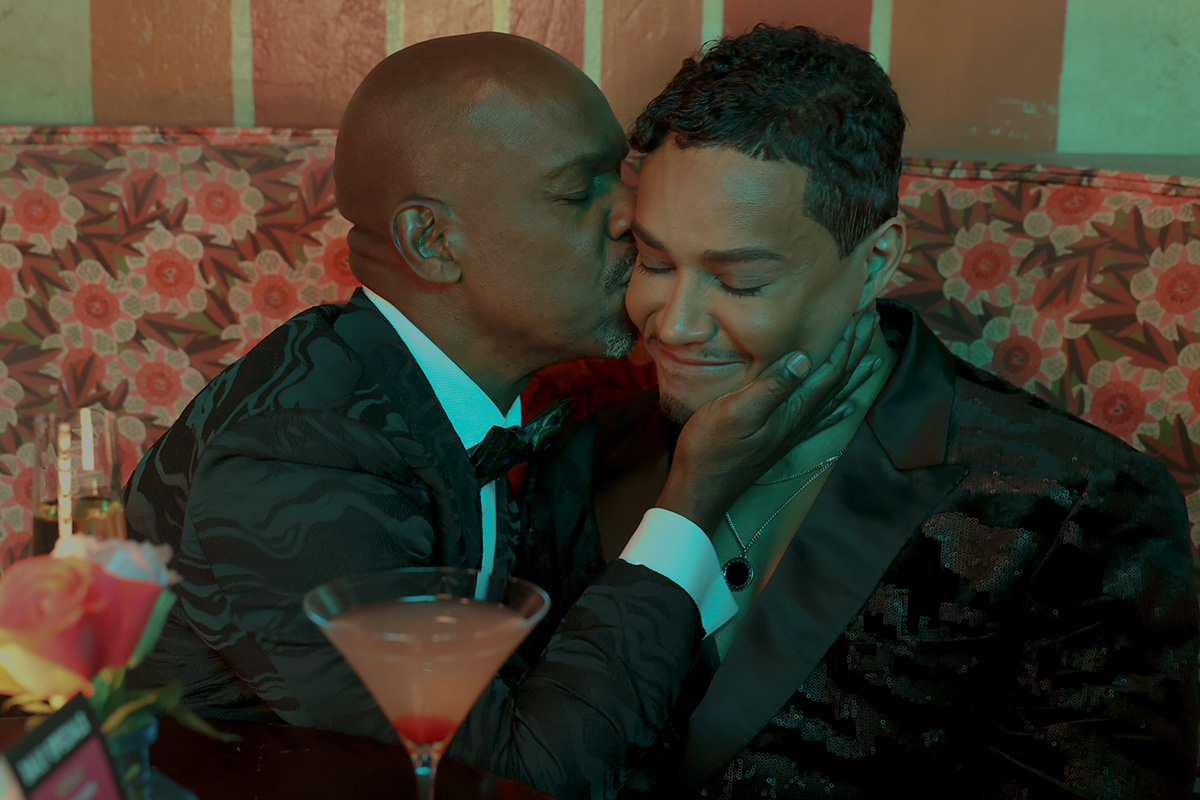
There’s no question that when Patrik-Ian Polk’s series “Noah’s Arc” premiered on Logo 20 years ago, it was a groundbreaking creation. The story of a group of Black gay men and their wonderful friendship. The titular arc was that of the cute main character, Noah (Darryl Stephens), and his close-knit circle of friends, including Chance played by gay actor Doug Spearman. This compelling and loving fraternity may, in fact, be what brought viewers back repeatedly, including a 2008 movie, “Noah’s Arc: Jumping the Broom,” as well as the 2020 “Noah’s Arc” short, and now, a new full-length feature “Noah’s Arc: The Movie,” debuting on Paramount+ on June 20. In the movie, filled with equal measures of laughs and tears, Chance, who has faced a devastating loss, finds his dependable friends there, ready to support and comfort him at a moment’s notice. I had the pleasure of speaking with Spearman the morning of the streaming premiere of “Noah’s Arc: The Movie.”
WASHINGTON BLADE: Doug, since the early 2000s, when the “Noah’s Arc” series premiered on Logo, you have been playing the character of Chance, including in the latest installment, “Noah’s Arc: The Movie.” What was it about Chance that appealed to you as an actor?
SPEARMAN: When Patrik (-Ian Polk) called me to ask me to play him (Chance), I was at JFK airport in the baggage claim, waiting for a suitcase. He explained what the part was. The thing that stuck out to me was the fact that Chance was in a long-term relationship with another Black man. And, they had a child; they had a 4-year-old daughter named Kenya. I had never seen two Black gay men raise a child on TV before. I thought it was the most revolutionary thing I’d ever seen. I immediately thought I’ve got to do this because that was something nobody had seen. I thought it was incredibly important to take the part.
BLADE: “Noah’s Arc: The Movie” was, once again, written and directed by Patrik-Ian Polk, who you just mentioned, is the creator of the entire franchise. What’s the secret to your long-standing working relationship?
SPEARMAN: [Laughs] the whole team, all of us, are like a band of brothers. We fight like brothers, we come together like brothers, we hash things out, we talk, because we’re all very different from our characters. I think the challenge of playing these guys and then uplifting these men, playing a part, especially something written by Patrik, is like solving a math equation. There’s always a challenge that’s enjoyable for me as an actor: to try to find out what it is that Patrik wants, and then how do I do it.
BLADE: I think you do a very good job of it.
SPEARMAN: Thank you very much
BLADE: In the years between “Jumping the Broom” and the new full-length movie, many changes have occurred, and the story addresses some of them, including gay widowhood, which is something that the aging community is now confronting, as well as mental health issues. Please say a few words about how you approached those subjects in the new movie.
SPEARMAN: I had a lot of loss in my life, right before we started shooting. Two months before we started shooting the first series, my mother died. I was going through the grief process through that whole first season. Since then, I’ve lost a lot of people in my life. In fact, when we started shooting the second season, the second week we were shooting, my ex died of a heart attack. I was having to fold that into what I was doing with my life on the set and off the set. You’ve got to show up and you’ve got to do your work. The first two seasons of “Noah’s Arc” are always tinged with the memory of grief. So, when I had to deal with the death that Chance faces (in the new movie), which is a significant death in his life, it wasn’t that hard to reach back, especially the scene in the graveyard. It was something that I unfortunately could pull from personal experience.
BLADE: Shifting gears, the movie features delightful cast surprises, including Jasmine Guy and TS Madison. Did you have a chance to interact with either or both when they were on set?
SPEARMAN: No, I didn’t have any scenes with Jasmine, and I missed her. I wish I had gotten to see her because I actually got to direct Jasmine for a CBS promo shoot for “Queen,” back in the early ‘90s. I had a huge crush on her when she was on “A Different World.” So, I really would have liked to reconnect. But TS and I got to see each other every day because I was in all her scenes. It was extraordinary being around somebody like that. That is one outspoken woman!
BLADE: Even though Beyoncé never makes an appearance in the movie, there’s a lot of talk about her. Would you say you are a Beyoncé fan?
SPEARMAN: Yes! I’m breathing! Yes, I’m a Beyoncé fan. I actually got the chance to meet her. I knew her mom. Her mom was extraordinary to me. She is in the second movie I directed. She also gave us a wedding gown to use in the very first scene of the movie. That family is extraordinarily important to me. Not only just to be a fan, but to be somebody who’s gotten to know them and work with them and see how hard they work. I don’t think anybody works as hard as Tina or Beyoncé.
BLADE: There was a recent news item about gay actor Benito Skinner of the Amazon Prime series “Overcompensating” being told not to bother auditioning for straight roles. As an out actor yourself, how important do you think it is for queer characters to be portrayed by queer actors, and vice versa?
SPEARMAN: Being queer is a multifaceted identity. There’s no one kind of queer person. I think finding the best actor that’s your first circle of casting. I think one of the joys about being an actor is that you get to play different parts. I play straight guys all the time. Dads and husbands and things like that. I think a lot of people are told not to do it. In fact, I wouldn’t be Chance if the actor who was originally cast as Chance hadn’t been pulled out of the series by his agents because they didn’t want him to play a gay character.
BLADE: That’s amazing! Thank you for sharing that. Without giving away too much, the ending of the movie is a little ambiguous, even ending with a question mark. If there was a “Noah’s Arc: The Movie” sequel, would you come back for that?
SPEARMAN: Yeah! A lot of it would depend on what Chance’s journey is going to be like. Patrik and I have conversations like that all the time. He’s very interested and supportive of input. I hope I would be, as we all would be, part of the creative growth with these characters. They live in Patrik’s head, and he writes them, but we’re the ones who have to flesh them out. It’s a conversation, it’s always a conversation.
BLADE: You are currently performing in Molière’s “The Imaginary Invalid” as part of the New Orleans Shakespeare Festival at Tulane. What has this experience been like for you?
SPEARMAN: It’s extraordinary! I started on stage when I was seven. There’s nothing like working with a live audience and having that immediacy. I’m working with an extraordinarily talented cast in a really great play, and I have some of the best scene partners I could ever want.
BLADE: Are there any upcoming film or TV projects you’d like to mention?
SPEARMAN: I’m still a writer, and I’m still a director, and I’ve still got scripts that I would like to make. I have a little something that’s a cross between “Treme” and “Bridgerton” that I want to do. I’m always trying to figure out what the next thing is.
a&e features
Visit Cambridge, a ‘beautiful secret’ on Maryland’s Eastern Shore
New organization promotes town’s welcoming vibe, LGBTQ inclusion
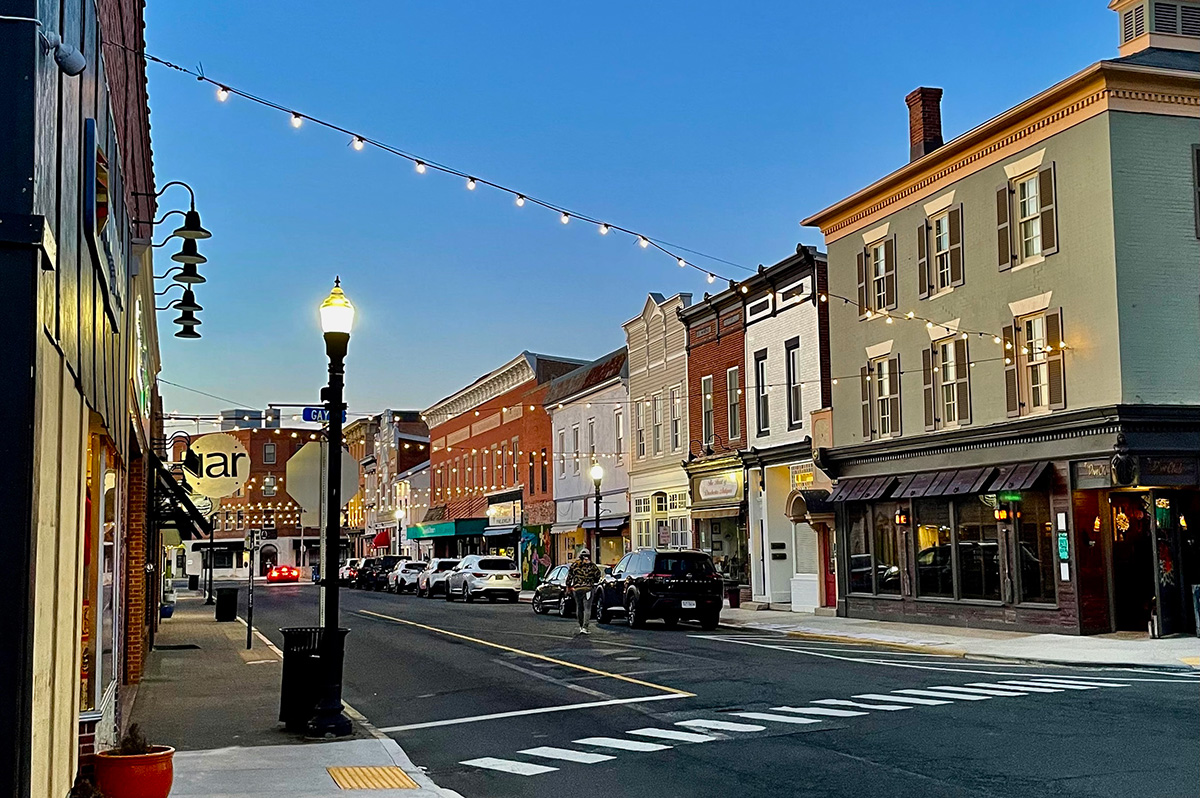
CAMBRIDGE, Md. — Driving through this scenic, historic town on Maryland’s Eastern Shore, you’ll be charmed by streets lined with unique shops, restaurants, and beautifully restored Victorian homes. You’ll also be struck by the number of LGBTQ Pride flags flying throughout the town.
The flags are a reassuring signal that everyone is welcome here, despite the town’s location in ruby red Dorchester County, which voted for Donald Trump over Kamala Harris by a lopsided margin. But don’t let that deter you from visiting. A new organization, Proudly Cambridge, is holding its debut Pride event this weekend, touting the town’s welcoming, inclusive culture.
“We stumbled on a beautiful secret and we wanted to help get the word out,” said James Lumalcuri of the effort to create Proudly Cambridge.
The organization celebrates diversity, enhances public spaces, and seeks to uplift all that Cambridge has to share, according to its mission statement, under the tagline “You Belong Here.”
The group has so far held informal movie nights and a picnic and garden party; the launch party is June 28 at the Cambridge Yacht Club, which will feature a Pride celebration and tea dance. The event’s 75 tickets sold out quickly and proceeds benefit DoCo Pride.
“Tickets went faster than we imagined and we’re bummed we can’t welcome everyone who wanted to come,” Lumalcuri said, adding that organizers plan to make “Cheers on the Choptank” an annual event with added capacity next year.
One of the group’s first projects was to distribute free Pride flags to anyone who requested one and the result is a visually striking display of a large number of flags flying all over town. Up next: Proudly Cambridge plans to roll out a program offering affirming businesses rainbow crab stickers to show their inclusiveness and LGBTQ support. The group also wants to engage with potential visitors and homebuyers.
“We want to spread the word outside of Cambridge — in D.C. and Baltimore — who don’t know about Cambridge,” Lumalcuri said. “We want them to come and know we are a safe haven. You can exist here and feel comfortable and supported by neighbors in a way that we didn’t anticipate when we moved here.”
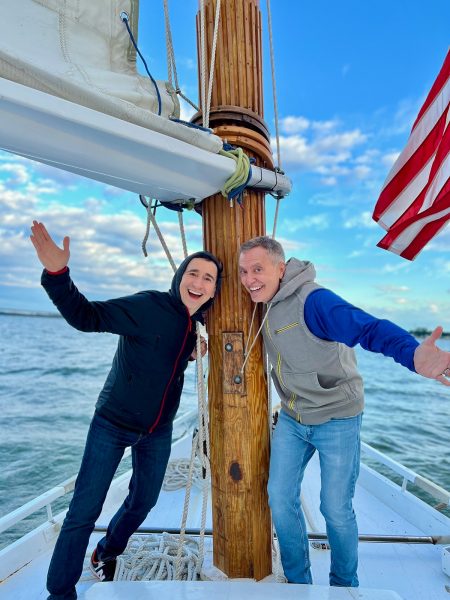
Lumalcuri, 53, a federal government employee, and his husband, Lou Cardenas, 62, a Realtor, purchased a Victorian house in Cambridge in 2021 and embarked on an extensive renovation. The couple also owns a home in Adams Morgan in D.C.
“We saw the opportunity here and wanted to share it with others,” Cardenas said. “There’s lots of housing inventory in the $300-400,000 range … we’re not here to gentrify people out of town because a lot of these homes are just empty and need to be fixed up and we’re happy to be a part of that.”
Lumalcuri was talking with friends one Sunday last year at the gazebo (affectionately known as the “gayzebo” by locals) at the Yacht Club and the idea for Proudly Cambridge was born. The founding board members are Lumalcuri, Corey van Vlymen, Brian Orjuela, Lauren Mross, and Caleb Holland. The group is currently working toward forming a 501(c)3.
“We need visibility and support for those who need it,” Mross said. “We started making lists of what we wanted to do and the five of us ran with it. We started meeting weekly and solidified what we wanted to do.”
Mross, 50, a brand strategist and web designer, moved to Cambridge from Atlanta with her wife three years ago. They knew they wanted to be near the water and farther north and began researching their options when they discovered Cambridge.
“I had not heard of Cambridge but the location seemed perfect,” she said. “I pointed on a map and said this is where we’re going to move.”
The couple packed up, bought a camper trailer and parked it in different campsites but kept coming back to Cambridge.
“I didn’t know how right it was until we moved here,” she said. “It’s the most welcoming place … there’s an energy vortex here – how did so many cool, progressive people end up in one place?”
Corey van Vlymen and his husband live in D.C. and were looking for a second home. They considered Lost River, W.Va., but decided they preferred to be on the water.
“We looked at a map on both sides of the bay and came to Cambridge on a Saturday and bought a house that day,” said van Vlymen, 39, a senior scientist at Booz Allen Hamilton. They’ve owned in Cambridge for two years.
They were drawn to Cambridge due to its location on the water, the affordable housing inventory, and its proximity to D.C.; it’s about an hour and 20 minutes away.
Now, through the work of Proudly Cambridge, they hope to highlight the town’s many attributes to residents and visitors alike.
“Something we all agree on is there’s a perception problem for Cambridge and a lack of awareness,” van Vlymen said. “If you tell someone you’re going to Cambridge, chances are they think, ‘England or Massachusetts?’”
He cited the affordability and the opportunity to save older, historic homes as a big draw for buyers.
“It’s all about celebrating all the things that make Cambridge great,” Mross added. “Our monthly social events are joyful and celebratory.” A recent game night drew about 70 people.
She noted that the goal is not to gentrify the town and push longtime residents out, but to uplift all the people who are already there while welcoming new visitors and future residents.
They also noted that Proudly Cambridge does not seek to supplant existing Pride-focused organizations. Dorchester County Pride organizes countywide Pride events and Delmarva Pride was held in nearby Easton two weeks ago.
“We celebrate all diversity but are gay powered and gay led,” Mross noted.
To learn more about Proudly Cambridge, visit the group on Facebook and Instagram.
What to see and do
Cambridge, located 13 miles up the Choptank River from the Chesapeake Bay, has a population of roughly 15,000. It was settled in 1684 and named for the English university town in 1686. It is home to the Harriet Tubman Museum, mural, and monument. Its proximity to the Blackwater National Wildlife Refuge makes it a popular stop for birders, drawn to more than 27,000 acres of marshland dubbed “the Everglades of the north.”
The refuge is walkable, bikeable, and driveable, making it an accessible attraction for all. There are kayaking and biking tours through Blackwater Adventures (blackwateradventuresmd.com).
Back in town, take a stroll along the water and through historic downtown and admire the architecture. Take in the striking Harriet Tubman mural (424 Race St.). Shop in the many local boutiques, and don’t miss the gay-owned Shorelife Home and Gifts (421 Race St.), filled with stylish coastal décor items.
Stop for breakfast or lunch at Black Water Bakery (429 Race St.), which offers a full compliment of coffee drinks along with a build-your-own mimosa bar and a full menu of creative cocktails.
The Cambridge Yacht Club (1 Mill St.) is always bustling but you need to be a member to get in. Snapper’s on the water is temporarily closed for renovations. RaR Brewing (rarbrewing.com) is popular for craft beers served in an 80-year-old former pool hall and bowling alley. The menu offers burgers, wings, and other bar fare.
For dinner or wine, don’t miss the fantastic Vintage 414 (414 Race St.), which offers lunch, dinner, wine tasting events, specialty foods, and a large selection of wines. The homemade cheddar crackers, inventive flatbreads, and creative desserts (citrus olive oil cake, carrot cake trifle) were a hit on a recent visit.
Also nearby is Ava’s (305 High St.), a regional chain offering outstanding Italian dishes, pizzas, and more.
For something off the beaten path, visit Emily’s Produce (22143 Church Creek Rd.) for its nursery, produce, and prepared meals.
“Ten minutes into the sticks there’s a place called Emily’s Produce, where you can pay $5 and walk through a field and pick sunflowers, blueberries, you can feed the goats … and they have great food,” van Vlymen said.
As for accommodations, there’s the Hyatt Regency Chesapeake Bay (100 Heron Blvd. at Route 50), a resort complex with golf course, spa, and marina. Otherwise, check out Airbnb and VRBO for short-term rentals closer to downtown.
Its proximity to D.C. and Baltimore makes Cambridge an ideal weekend getaway. The large LGBTQ population is welcoming and they are happy to talk up their town and show you around.
“There’s a closeness among the neighbors that I wasn’t feeling in D.C.,” Lumalcuri said. “We look after each other.”
a&e features
James Baldwin bio shows how much of his life is revealed in his work
‘A Love Story’ is first major book on acclaimed author’s life in 30 years

‘Baldwin: A Love Story’
By Nicholas Boggs
c.2025, FSG
$35/704 pages
“Baldwin: A Love Story” is a sympathetic biography, the first major one in 30 years, of acclaimed Black gay writer James Baldwin. Drawing on Baldwin’s fiction, essays, and letters, Nicolas Boggs, a white writer who rediscovered and co-edited a new edition of a long-lost Baldwin book, explores Baldwin’s life and work through focusing on his lovers, mentors, and inspirations.
The book begins with a quick look at Baldwin’s childhood in Harlem, and his difficult relationship with his religious, angry stepfather. Baldwin’s experience with Orilla Miller, a white teacher who encouraged the boy’s writing and took him to plays and movies, even against his father’s wishes, helped shape his life and tempered his feelings toward white people. When Baldwin later joined a church and became a child preacher, though, he felt conflicted between academic success and religious demands, even denouncing Miller at one point. In a fascinating late essay, Baldwin also described his teenage sexual relationship with a mobster, who showed him off in public.
Baldwin’s romantic life was complicated, as he preferred men who were not outwardly gay. Indeed, many would marry women and have children while also involved with Baldwin. Still, they would often remain friends and enabled Baldwin’s work. Lucien Happersberger, who met Baldwin while both were living in Paris, sent him to a Swiss village, where he wrote his first novel, “Go Tell It on the Mountain,” as well as an essay, “Stranger in the Village,” about the oddness of being the first Black person many villagers had ever seen. Baldwin met Turkish actor Engin Cezzar in New York at the Actors’ Studio; Baldwin later spent time in Istanbul with Cezzar and his wife, finishing “Another Country” and directing a controversial play about Turkish prisoners that depicted sexuality and gender.
Baldwin collaborated with French artist Yoran Cazac on a children’s book, which later vanished. Boggs writes of his excitement about coming across this book while a student at Yale and how he later interviewed Cazac and his wife while also republishing the book. Baldwin also had many tumultuous sexual relationships with young men whom he tried to mentor and shape, most of which led to drama and despair.
The book carefully examines Baldwin’s development as a writer. “Go Tell It on the Mountain” draws heavily on his early life, giving subtle signs of the main character John’s sexuality, while “Giovanni’s Room” bravely and openly shows a homosexual relationship, highly controversial at the time. “If Beale Street Could Talk” features a woman as its main character and narrator, the first time Baldwin wrote fully through a woman’s perspective. His essays feel deeply personal, even if they do not reveal everything; Lucian is the unnamed visiting friend in one who the police briefly detained along with Baldwin. He found New York too distracting to write, spending his time there with friends and family or on business. He was close friends with modernist painter Beauford Delaney, also gay, who helped Baldwin see that a Black man could thrive as an artist. Delaney would later move to France, staying near Baldwin’s home.
An epilogue has Boggs writing about encountering Baldwin’s work as one of the few white students in a majority-Black school. It helpfully reminds us that Baldwin connects to all who feel different, no matter their race, sexuality, gender, or class. A well-written, easy-flowing biography, with many excerpts from Baldwin’s writing, it shows how much of his life is revealed in his work. Let’s hope it encourages reading the work, either again or for the first time.
-

 U.S. Supreme Court2 days ago
U.S. Supreme Court2 days agoSupreme Court to consider bans on trans athletes in school sports
-

 Out & About3 days ago
Out & About3 days agoCelebrate the Fourth of July the gay way!
-

 Virginia3 days ago
Virginia3 days agoVa. court allows conversion therapy despite law banning it
-

 Maryland5 days ago
Maryland5 days agoLGBTQ suicide prevention hotline option is going away. Here’s where else to go in Md.

